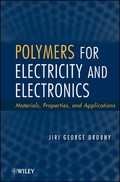Polymers for Electricity and Electronics
Materials, Properties, and Applications

1. Auflage Februar 2012
352 Seiten, Hardcover
Wiley & Sons Ltd
Kurzbeschreibung
This book introduces readers to the fundamentals, basic principles, properties, and applications of electrical polymers. It provides the principles in an extended and accessible way, as well as including examples of state-of-the-art scientific issues. The book evaluates emerging technologies such as light emitting diodes, soft electronics, and conductive fibers used for smart clothing or electromagnetic shields, and explains the advantages of conductive polymers as well as their processibility and commercial use. The coverage includes problems for study with solutions within chapters on chemical and physical properties and basic concepts.
The comprehensive, practical book that explores the principles, properties, and applications of electrical polymers
The electrical properties of polymers present almost limitless possibilities for industrial research and development, and this book provides an in-depth look at these remarkable molecules. In addition to traditional applications in insulating materials, wires, and cables, electrical polymers are increasingly being used in a range of emerging technologies.
Presenting a comprehensive overview of how electrical polymers function and how they can be applied in the electronics, automotive, medical, and military fields, Polymers for Electricity and Electronics: Materials, Properties, and Applications presents intensive and accessible coverage with a focus on practical applications. Including examples of state-of-the-art scientific issues, the book evaluates new technologies--such as light emitting diodes, molecular electronics, liquid crystals, nanotechnology, optical fibers, and soft electronics--and explains the advantages of conductive polymers as well as their processibility and commercial uses.
This book is an essential resource for anyone working with, or interested in, polymers and polymer science. In addition, appendices that detail the electrical properties of selected polymers as well as list additional ASTM and corresponding international testing standards and methods for testing electrical properties are also included.
1 INTRODUCTION 1
1.1 Electric Charge 3
1.2 Coulomb's Law 6
1.3 Conductors and Insulators 7
1.4 Capacitors 7
1.5 Dielectrics and Capacitance 8
1.6 Dielectric Polarizability 12
1.7 Voltage 15
1.8 Electric Currents 16
1.9 Resistance and Resistivity 17
1.10 Ohm's Law 19
1.11 Semiconductors 19
1.12 Superconductivity and Superconductors 20
1.13 Piezoelectricity 21
1.14 Pyroelectricity 21
1.15 Ferroelectricity 22
1.16 Methods for Generating Electric Energy 22
2 POLYMERIC MATERIALS 27
2.1 Introduction 27
2.2 Polymerization / 33
2.3 Molecular Weights and Molecular Weight Distributions 34
2.4 Configuration 36
2.5 Glass Transition Temperature and Melting Temperature 38
2.6 Solutions of Polymers 42
2.7 Polymer Compatibility 47
2.8 Deformation Behavior 47
2.9 Polymeric Foams 55
2.10 Liquid Crystals 56
2.11 Nanocomposites 59
2.12 Commercial Polymers 60
2.13 General Technological Characteristics of Polymers 90
2.14 Processing of Polymers 96
2.15 Adhesion and Adhesives 114
3 POLYMERS AS ELECTRICAL INSULATORS 134
3.1 Dielectric Constants of Polymers 135
3.2 Dielectric Relaxation 140
3.3 Tangent of the Dielectric Loss Angle 143
3.4 Dielectric Breakdown of Polymers 147
3.5 Static Charges 159
4 SPECIALTY POLYMERS 172
4.1 Intrinsically Conductive Polymers 172
4.2 Ferroelectric Polymers 180
4.3 Thermotropic Liquid-Crystal Polymers 185
4.4 Ionomers 186
5 COMMERCIAL POLYMERS USED IN PRACTICAL ELECTRICAL AND ELECTRONIC APPLICATIONS 193
5.1 Polymeric Materials Used As Insulators 193
5.2 Wire and Cable Technology 205
5.3 Other Applications of Polymers and Polymeric Systems 245
6 APPLICATIONS OF SPECIALTY POLYMERS 253
6.1 Applications of Conjugated Polymers 253
6.2 Applications of Ferroelectric Polymers 258
6.3 Applications of Liquid-Crystal Polymers 259
6.4 Applications of Ionomers 261
6.5 Lithium Ion Polymer Batteries 265
7 TESTING OF ELECTRICAL PROPERTIES OF POLYMERS 269
7.1 Introduction 269
7.2 Individual Tests of Electrical Properties 271
8 CURRENT TRENDS AND DEVELOPMENTS 280
8.1 Molecular Electronics 281
8.2 Intelligent Material Systems 281
8.3 Other Developments and Trends 282
Further Readings 286
APPENDIX I TYPICAL VALUES OF ELECTRICAL PROPERTIES OF SELECTED POLYMERS 289
APPENDIX II ELECTRICAL PROPERTIES, ASTM TEST METHODS, AND SPECIFICATIONS 292
APPENDIX III BASIC ELECTRICAL TESTS: ASTM AND CORRESPONDING INTERNATIONAL STANDARDS 294
APPENDIX IV NOBEL PRIZE 2000 FOR CHEMISTRY, TITLE PAGE 295
ACRONYMS AND ABBREVIATIONS 297
GLOSSARY 304
BIBLIOGRAPHY 314
INDEX 317


